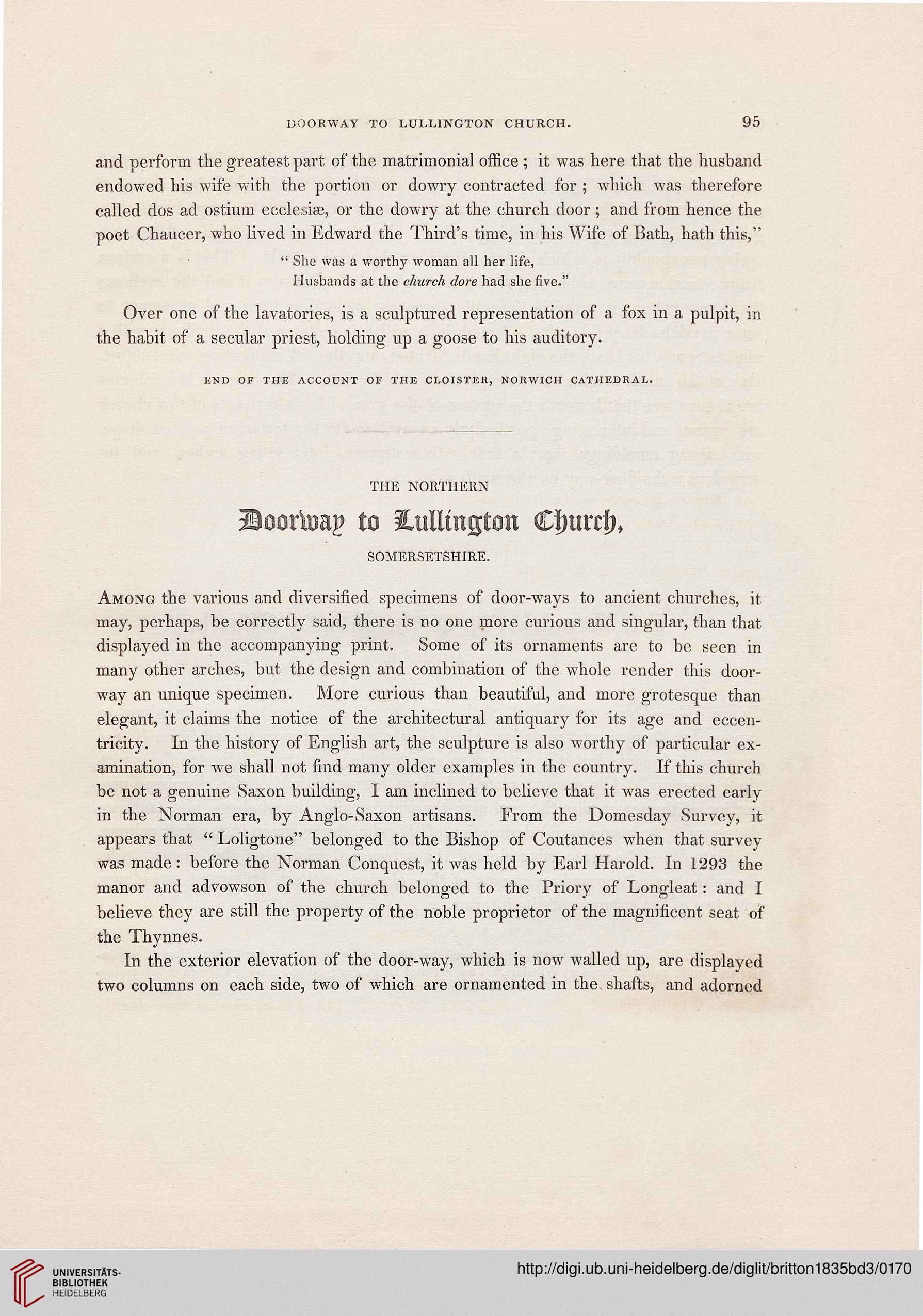doorway to lullington church.
95
and perform the greatest part of the matrimonial office ; it was here that the husband
endowed his wife with the portion or dowry contracted for ; which was therefore
called dos ad ostium ecclesise, or the dowry at the church door; and from hence the
poet Chaucer, who lived in Edward the Third's time, in his Wife of Bath, hath this,"
" She was a worthy woman all her life,
Husbands at the church dore had she five."
Over one of the lavatories, is a sculptured representation of a fox in a pulpit, in
the habit of a secular priest, holding up a goose to his auditory.
END OF THE ACCOUNT OF THE CLOISTER, NORWICH CATHEDRAL.
THE NORTHERN
Uoortoap to Huiltngton Cfjurcf),
SOMERSETSHIRE.
Among the various and diversified specimens of door-ways to ancient churches, it
may, perhaps, be correctly said, there is no one more curious and singular, than that
displayed in the accompanying print. Some of its ornaments are to be seen in
many other arches, but the design and combination of the whole render this door-
way an unique specimen. More curious than beautiful, and more grotesque than
elegant, it claims the notice of the architectural antiquary for its age and eccen-
tricity. In the history of English art, the sculpture is also worthy of particular ex-
amination, for we shall not find many older examples in the country. If this church
be not a genuine Saxon building, I am inclined to believe that it was erected early
in the Norman era, by Anglo-Saxon artisans. From the Domesday Survey, it
appears that " Loligtone" belonged to the Bishop of Coutances when that survey
was made : before the Norman Conquest, it was held by Earl Harold. In 1293 the
manor and advowson of the church belonged to the Priory of Longleat: and I
believe they are still the property of the noble proprietor of the magnificent seat of
the Thynnes.
In the exterior elevation of the door-way, which is now walled up, are displayed
two columns on each side, two of which are ornamented in the. shafts, and adorned
95
and perform the greatest part of the matrimonial office ; it was here that the husband
endowed his wife with the portion or dowry contracted for ; which was therefore
called dos ad ostium ecclesise, or the dowry at the church door; and from hence the
poet Chaucer, who lived in Edward the Third's time, in his Wife of Bath, hath this,"
" She was a worthy woman all her life,
Husbands at the church dore had she five."
Over one of the lavatories, is a sculptured representation of a fox in a pulpit, in
the habit of a secular priest, holding up a goose to his auditory.
END OF THE ACCOUNT OF THE CLOISTER, NORWICH CATHEDRAL.
THE NORTHERN
Uoortoap to Huiltngton Cfjurcf),
SOMERSETSHIRE.
Among the various and diversified specimens of door-ways to ancient churches, it
may, perhaps, be correctly said, there is no one more curious and singular, than that
displayed in the accompanying print. Some of its ornaments are to be seen in
many other arches, but the design and combination of the whole render this door-
way an unique specimen. More curious than beautiful, and more grotesque than
elegant, it claims the notice of the architectural antiquary for its age and eccen-
tricity. In the history of English art, the sculpture is also worthy of particular ex-
amination, for we shall not find many older examples in the country. If this church
be not a genuine Saxon building, I am inclined to believe that it was erected early
in the Norman era, by Anglo-Saxon artisans. From the Domesday Survey, it
appears that " Loligtone" belonged to the Bishop of Coutances when that survey
was made : before the Norman Conquest, it was held by Earl Harold. In 1293 the
manor and advowson of the church belonged to the Priory of Longleat: and I
believe they are still the property of the noble proprietor of the magnificent seat of
the Thynnes.
In the exterior elevation of the door-way, which is now walled up, are displayed
two columns on each side, two of which are ornamented in the. shafts, and adorned




